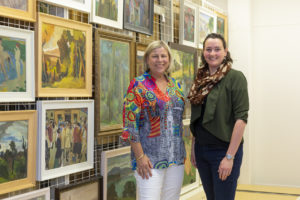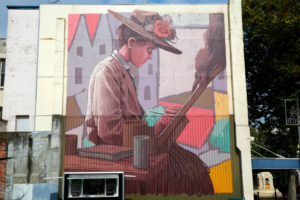04 Feb Sarjeant Happenings: Intern unravels Edith Collier mysteries
By Rose Collier, Whanganui Chronicle

Fiona Horrocks (left), the great niece of Edith Collier with Rose Collier, a great great niece and author of this article.
For a few weeks in January 2020 I stayed in Whanganui and volunteered as an intern at Sarjeant on the Quay.
I was lucky enough to hear about the internship from Jennifer Taylor Moore, the Sarjeant’s Curator of Collections when I was visiting from Dunedin with my mother in November last year.
We had come to the Sarjeant to view the Edith Collier works that are in the care of the Gallery. The early Modernist painter, who was from Whanganui, is my ancestor (my great, great Auntie), and I was very keen to assist with cataloguing the Edith Collier Trust archive.
Since I first came to Whanganui in 2006, Edith has been a feature of my creative work, both as an influence on my own art and in my writing.
Being able to explore the Edith Collier archive has given me a window into Edith’s time overseas between 1913 to 1922, which I have always found fascinating.
Fortunately Edith and her family wrote to each other frequently, and there is a wealth of knowledge in the archive. There are postcards written days after the Armistice of World War I; words of encouragement from the Australian painter Margaret MacPherson (nee Preston) and insights into what life was like for a woman traveling through Europe 100 years ago.
My internship involved looking closely at photographs and postcards, assessing their condition, noting physical details and who or what was featured in them.
It was amazing to see original photographs from her time in Great Britain and to see some of the figures and places that she painted.
I particularly enjoyed solving a few mysteries: like which bridge in London was it that Edith and her relatives are journeying under by boat?
And working out exactly which family members are in a 100-year-old photograph. I have had some experience reading difficult handwriting (as I work with doctors) so I had fun getting to know Edith’s tricky cursive script.
Edith’s paintings explore so much of what I love about the countryside in Great Britain where I grew up.
In places like Bonmahon in Ireland and St Ives in Cornwall near where I was born, she captures the essence of both the land and the people who dwell there.
The landscapes are full of trees and cottages, small settlements where peoples’ impact on the world was minimal. Edith has painted these small rural communities in vivid colours with the stories of life’s struggles and challenges written on the faces of her subjects.
Often Edith Collier’s story is remembered with a sense of loss: of what might have been had she continued painting later in life. Reading through postcards, looking at photographs and really engaging with the history of her time overseas, I am struck by the enormity of what she did achieve.
I think of Edith’s life as a triumph and not as a tale half told. What she captured on canvas was glorious and she was brave to journey into the unknown, challenging herself, pushing herself to keep creating. She has certainly been an inspiration to me and I enjoy sharing her story.

Whanganui Walls street art festival featuring a portrait of Edith Collier.
Jennifer Taylor Moore explained to me that it is hoped that Edith Collier’s artistic output and story will become far more widely known and that the work I have done in the archive is another vital step in enabling that to happen. I certainly hope so.
It was great to feel a sense of belonging in Whanganui and to meet some relatives I didn’t know I had. I’d like to thank the people who made it possible for me to stay and volunteer at the Sarjeant and all the wonderful people I met.
Click here to see the original article at nzherald.co.nz

